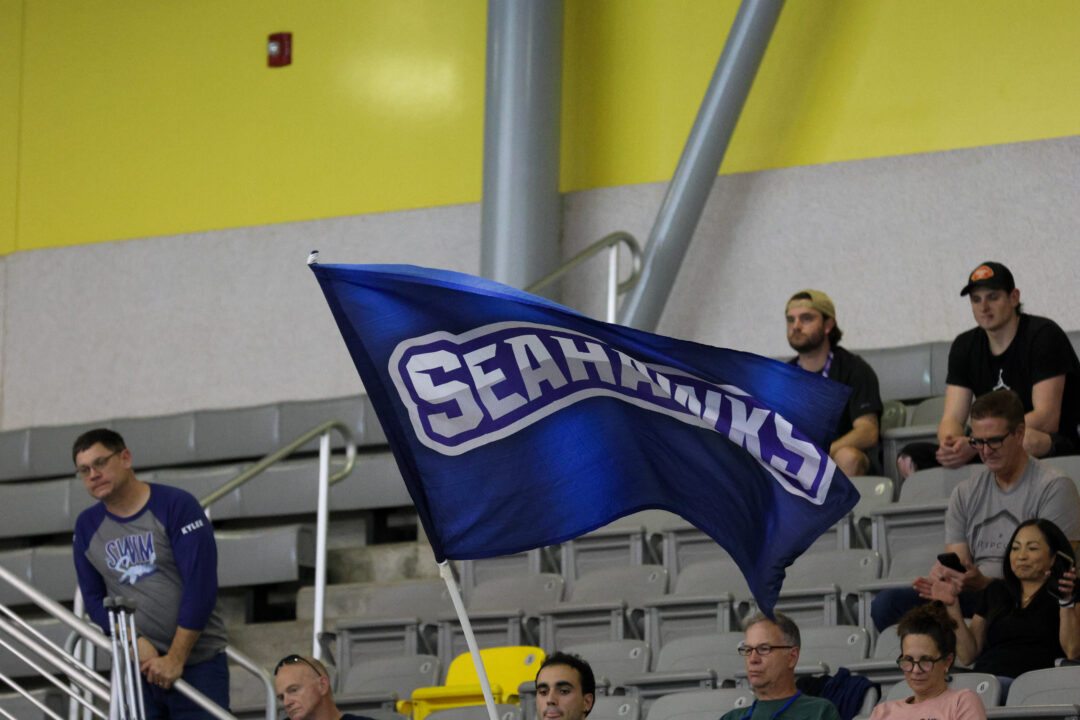The NAIA, a division of American college athletics outside of the NCAA system, has announced its time standards for the 2025 NAIA National Championship meets.
The 2025 championships will move to Elkhart, Indiana at the Elkhart Aquatics Center from March 5-8.
The 2025 automatic qualification standards are set based on the 3rd place finish at the last three NAIA National Championship meets, with the caveat that time standards can’t get slower from year to year.
Swimmers with automatic time standards earn an invite to the championship meet, and swimmers are added one-by-one to each event until the events have an even number of swimmers per event.
Then swimmers continue to be added in each event until all of the swimming spots (140 men, 160 women) are filled. When those thresholds are crossed, swimmers on that row that are closest to the NAIA Automatic Cut get chosen first.
While the Automatic standards are pragmatically moot in one sense, because swimmers under them will get chosen anything, they are impactful in terms of determining which swimmers get in and which don’t.
Once a swimmer is invited individually, they can swim up to two other individual events in which they have at least a provisional standard. If a swimmer has an A cut in one event, they don’t need a provisional standard in their other events to be invited. Historically, about 20-21 swimmers are invited per event to the men’s meet, and about 30 are invited per event to the women’s meet.
Each team can enter up to 18 athletes per gender (including alternates).
The Keiser University women dominated their meet last year, winning by 250.5 points ahead of the upstart St. Thomas University in Florida. The St. Thomas won the men’s title by 16 points ahead of Keiser.
St. Thomas launched its men’s and women’s swimming & diving programs in the 2020-2021 swimming.
Qualification Change for 2024-2025
After some contentions relay selections in prior years, the NAIA has simplified its relay selection procedures for the 2024-2025 season. Simply put: schools with 4 or more qualifiers are automatically entered in all relays.
They can only use swimmers who already qualified individually on those relays.
A similar system was installed ahead of the 2022-2023 season, though the automatic entry of relays is new for this season.
2025 Standards
All meters standards are in short course meters.
Men’s Standards:
| Event | Men Yards – A cut | Men Meters – A cut | Men Yards – B cut |
Men Meters – B cut
|
| 50 FREESTYLE | 20.20 | 22.60 | 21.95 | 24.56 |
| 100 FREESTYLE | 44.64 | 49.59 | 48.55 | 53.93 |
| 200 FREESTYLE | 1:38.53 | 1:49.14 | 1:47.69 | 1:59.32 |
| 500/400 FREESTYLE | 4:27.87 | 3:55.17 | 4:52.19 | 4:16.53 |
| 1650/1500 FREESTYLE | 15:53.98 | 15:41.73 | 17:26.99 | 17:13.55 |
| 100 BACKSTROKE | 48.93 | 54.36 | 54.3 | 1:00.32 |
| 200 BACKSTROKE | 1:47.39 | 1:59.20 | 1:58.46 | 2:11.49 |
| 100 BREASTSTROKE | 54.8 | 1:00.82 | 59.84 | 1:06.42 |
| 200 BREASTSTROKE | 2:00.05 | 2:13.25 | 2:12.30 | 2:26.85 |
| 100 BUTTERFLY | 48.64 | 54.18 | 53.05 | 59.09 |
| 200 BUTTERFLY | 1:49.63 | 2:02.12 | 2:00.34 | 2:14.05 |
| 200 INDIVIDUAL MEDLEY | 1:48.48 | 2:00.51 | 1:59.42 | 2:12.67 |
| 400 INDIVIDUAL MEDLEY | 3:56.15 | 4:22.35 | 4:23.49 | 4:52.73 |
Women’s Standards:
| Event | Women Yards – A | Women Meters – A cut | Women’s Yards – B cut |
Women Meters – B Cut
|
| 50 FREESTYLE | 23.60* | 26.43* | 25.58 | 28.52 |
| 100 FREESTYLE | 51.43* | 57.39* | 55.88 | 1:02.13 |
| 200 FREESTYLE | 1:52.26* | 2:04.86* | 2:03.09 | 2:16.38 |
| 500/400 FREESTYLE | 5:01.96* | 4:25.61* | 5:26.78 | 4:43.41 |
| 1650/1500 FREESTYLE | 17:32.66 | 17:19.49 | 19:04.99 | 18:50.29 |
| 100 BACKSTROKE | 56.85 | 1:03.15 | 1:02.44 | 1:09.37 |
| 200 BACKSTROKE | 2:02.68 | 2:16.17 | 2:15.99 | 2:31.08 |
| 100 BREASTSTROKE | 1:02.93 | 1:19.85 | 1:11.01 | 1:18.96 |
| 200 BREASTSTROKE | 2:17.13 | 2:32.21 | 2:34.86 | 2:52.20 |
| 100 BUTTERFLY | 56.13* | 1:02.89* | 1:01.59 | 1:08.42 |
| 200 BUTTERFLY | 2:05.79* | 2:20.24* | 2:19.99 | 2:35.52 |
| 200 INDIVIDUAL MEDLEY | 2:05.79* | 2:19.98* | 2:16.81 | 2:31.85 |
| 400 INDIVIDUAL MEDLEY | 4:33.21 | 5:02.42 | 4:58.70 | 5:31.55 |

I read the 2022 article and saw the reduction in swimmers from 2020 was so large, why not end up halfway in between? That was a 34% reduction in athletes for Nationals.
What about something like 156 men + 12 male divers, 176 women + 16 female divers, (for a total of 360 athletes) ?
The NAIA has a post season access ratio for national championships. The current numbers are still higher than what the NAIA has implements for all sports. This was the negotiaed amount by the national office, the Nation Advisory Council of the NAIA and the coaches.
Those meters vs yards discrepancies are crazy. Faster than olympic trials vs yards is slower than summer jnats
Those are SC Meters times, not LC Meters times.
more teams than ever in NAIA. Almost 50 now.
The changes with the relays took effect in 2023. They have been this way for the past two seasons.
no, they haven’t https://www.naia.org/pdf/2024_S-D_Spring_Updates.pdf
That was not a change. It was a language.
Swimming doesn’t drive the direction of an athletic department. OBU dropped their swim team. It’s always basketball, football or the best direction for the department or institution as a whole.